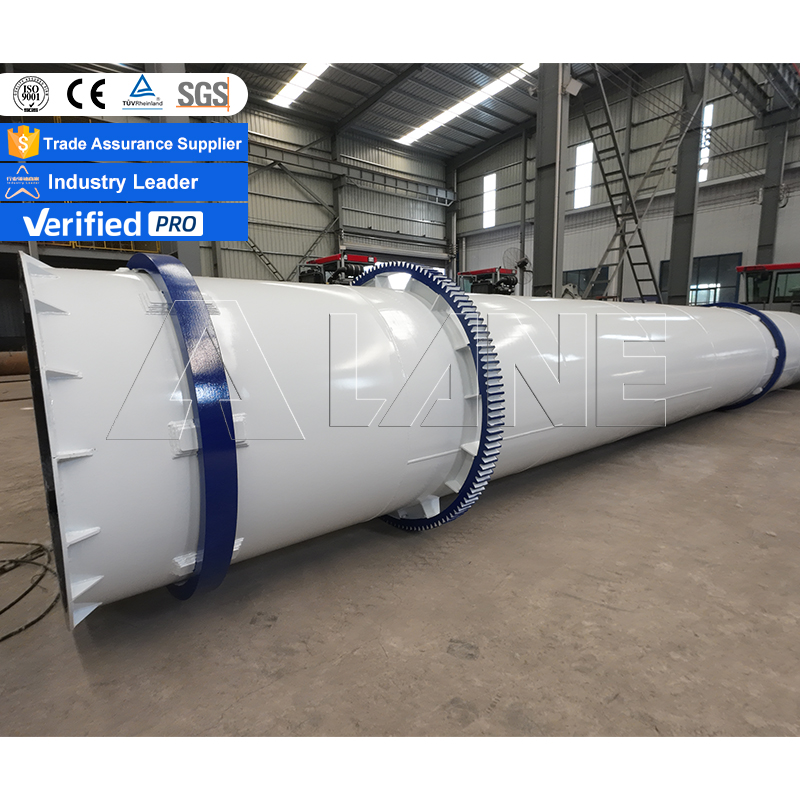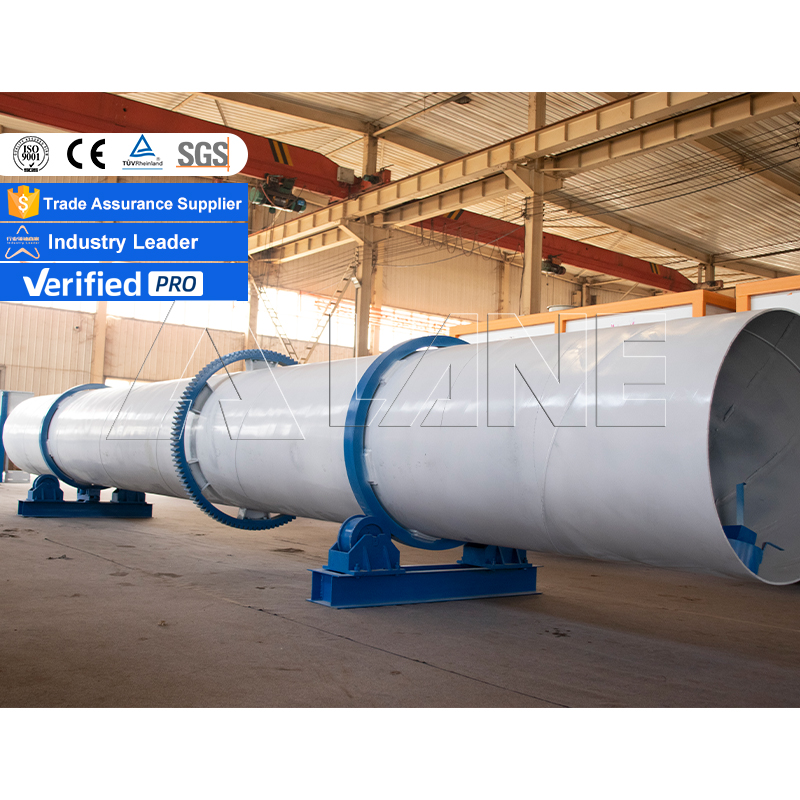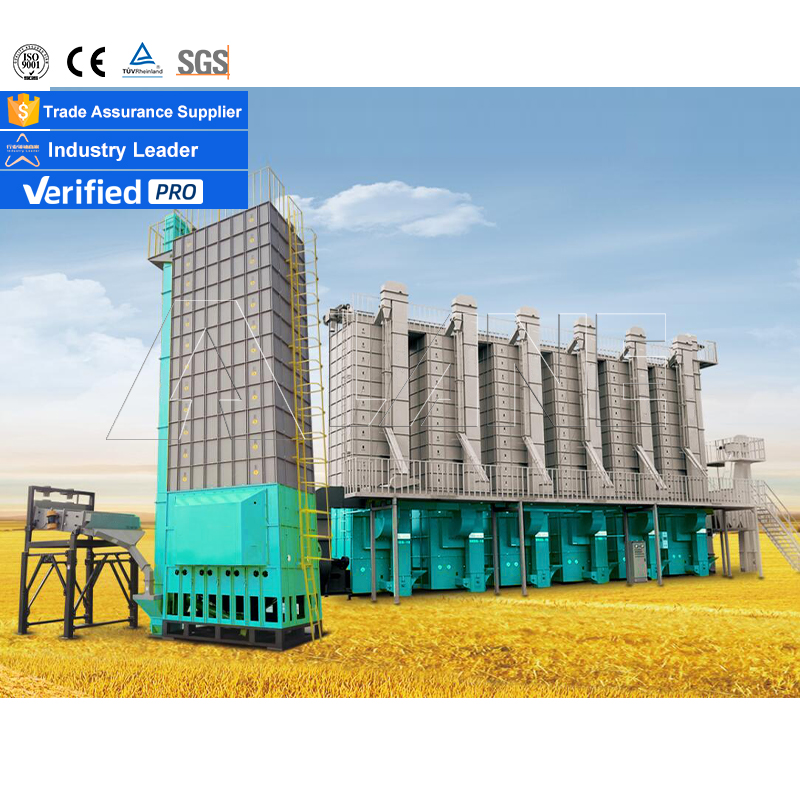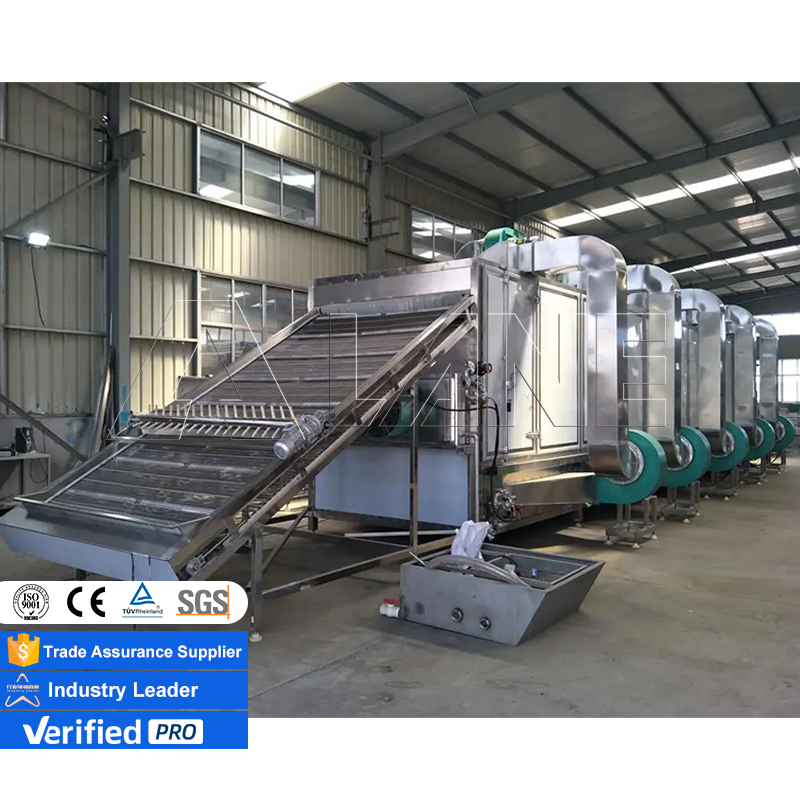
In fertilizer production, dryers and coolers are an essential part of ensuring that the material is handled correctly. These dryers use heat generated by coal or natural gas, which is then circulated through the dryer by fans to quickly remove moisture from the material. Once the drying process is complete, the cooler takes over, reducing the product temperature to a level suitable for packaging. These two steps help stabilize the fertilizer and ensure that it can be safely stored and shipped without compromising quality.

The rotary dryer operates by introducing heated air while the inclined drum continuously rotates, allowing wet materials to move forward and exchange heat effectively with the air. Widely used in agriculture, chemicals, and mining, it caters to various production scales and material types.
Constructed with a high-precision ground base, offering high concentricity and reduced wear, resulting in longer operational life.
The drum features flange connections, ensuring precise alignment and easy maintenance or replacement.

Rotary coolers are used in various industries, including fertilizers, cement, and metallurgy, designed for efficiently cooling high-temperature materials. The rotary cooling machine operates by rotating its drum at an incline, allowing hot materials to move forward while simultaneously coming into contact with ambient air. This interaction not only cools the material but also helps evaporate moisture, increasing the strength of granules.
The rotary cooler’s drum is processed using a ground-based lathe, ensuring precise concentricity, which minimizes wear and reduces energy consumption.
The drum is connected using high-precision flanges, allowing for easy maintenance and part replacement.



The tower grain dryer adopts the mixed flow drying principle recommended by experts, which has the advantages of high thermal efficiency and low energy consumption, and the moisture is dried slowly and evenly to ensure that there is no broken grain during the drying process.
This tower grain dryer is suitable for drying crops such as fertilizers, rice, soybeans, wheat, corn and rapeseed, and can meet your needs for drying grains in all seasons.
The tower grain dryer adopts a modular structure and can be adjusted according to output, usage, moisture, etc. to save energy to the maximum extent.

Fertilizer belt dryer is a kind of equipment used to dry fertilizers, which is widely used in agriculture, chemical industry and other fields. This type of equipment usually uses mesh belt as the transmission medium, and heats and dries the material evenly through the hot air circulation system, so as to achieve the purpose of reducing the moisture content.
Fertilizer belt dryer is not only suitable for drying organic fertilizer, granular feed and other fertilizers, but also can process other materials such as food, vegetables, tea, etc.
The structural design is diverse. According to different needs, the fertilizer belt dryer can be designed as a single-layer or multi-layer structure. It improves the drying efficiency and is suitable for large-scale production.






Drying serves two key purposes. First, it ensures that the raw materials meet the optimal moisture range required for effective granulation. The right moisture level allows the materials to effectively bond during the granulation process, ensuring that the fertilizer granules are strong and uniform.
Second, drying reduces the moisture content of the fertilizer, which prevents the fertilizer from clumping during storage and improves the strength of the granules. The tumbling action of the drum dryer smoothes the rough surface of the fertilizer and reduces dust generation, thereby producing a more uniform and higher quality product and maintaining the structural integrity of the fertilizer granules during application.
Drying also reduces transportation costs, as transporting fertilizer with high moisture content is inefficient and costly because it means transporting the weight of water. By drying the fertilizer, the plant can improve the quality of the product while shipping more per batch, thus saving on logistics expenses.
Rotary dryers have become an integral part of the fertilizer industry due to their versatility and effectiveness at multiple stages of production. These dryers are essential in processing minerals used as fertilizer raw materials. Many fertilizers start with mineral components that are mined from the ground. Before these minerals can be made into usable fertilizers, they must go through a beneficiation process, which almost always involves drying. This step removes excess water and prepares the pellets for subsequent granulation.
In the fertilizer production process, it is crucial to ensure the control of temperature and air flow during drying. Different types of fertilizers have different requirements for temperature and humidity. Excessive temperature or unstable air flow may cause melting, sticking or particle breakage of fertilizer particles, thus affecting the quality of the final product.
When using a rotary drum dryer, temperature control is the top priority. For example, for organic fertilizers, the ideal drying temperature should be kept below 60°C to protect the beneficial microorganisms in it from being destroyed. The temperature of the hot air entering the dryer should not exceed 130°C to ensure that the fertilizer particles are dried at the appropriate temperature.
Air flow also plays a key role, which directly affects the drying effect. Proper air flow helps maintain a stable temperature and ensures that each fertilizer particle can be dried evenly. Generally speaking, the air inlet and outlet temperatures of the dryer should be kept within a certain range. Reasonable adjustment of the air flow can avoid excessive temperature fluctuations during the drying process and ensure the consistency of the drying effect.
Through precise temperature and air flow control, the efficiency and stability of the fertilizer drying process can be ensured, thereby improving the quality and use effect of the fertilizer.
As a large-scale fertilizer production equipment, the installation process of the rotary drum dryer needs to be carried out strictly in accordance with the requirements of the assembly drawing and the foundation drawing. After the equipment is delivered, a comprehensive inspection is first required to ensure that all parts are complete and meet the quality standards. If parts are found to be missing or defective, the manufacturer should be communicated and resolved immediately.
Before installation, all parts should be thoroughly cleaned, including removing surface dirt and rust, to ensure the accuracy and reliability of equipment installation. At the same time, carefully reading the equipment drawings and familiarizing yourself with its structure and technical requirements is an important measure to avoid damage to the equipment.
The installation preparation work needs to be comprehensive and meticulous. In addition to being familiar with the relevant technical documents of the equipment, the required tools and installation equipment should be prepared, and a detailed construction plan should be made. During the actual installation process, all lifting operations must be carried out in strict accordance with safety standards to ensure the safety of lifting tools such as wire ropes and hooks. The cylinder and other components should be firmly fixed to the frame to avoid dragging the equipment directly on the ground or rollers.
Equipment positioning is one of the key steps in installation. On the basic standard plate, the cross curve and elevation line should be accurately drawn, and the center reference plate should be laid to ensure the accuracy of the installation. The installation of the base and wheels requires adjusting the shims to keep them level, and then positioning and grouting according to the instructions on the drawings. After the concrete reaches strength, tighten the anchor bolts to ensure that the cylinder is stable.
The installation of the roller and the cylinder requires special attention to the tightness of the joints. The concave and convex joints need to be positive and negative with appropriate gaps. The installation of the large gear is equally important. Before assembly, it is necessary to check the flatness and collision defects of its contact surface, and carefully calibrate it to ensure smooth operation. The installation of the small gear, reducer and motor requires parameter adjustment according to the position of the large gear to ensure that the equipment meets the technical requirements.
After all installation work is completed, secondary grouting is required, and the equipment is debugged and verified at the same time. The grouting process must follow the relevant regulations of civil engineering design, and the debugging work will verify the overall performance of the equipment and provide guarantee for subsequent commissioning.
Through the above steps, the installation of the rotary drum dryer will be more standardized and efficient. This will not only increase the service life of the equipment, but also provide reliable support for subsequent production.